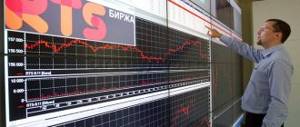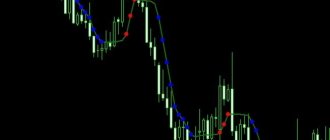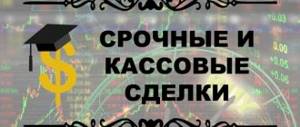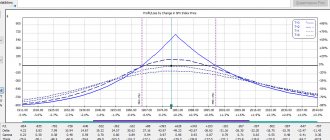Advantages and disadvantages of the market
Futures and options are excellent tools for short-term trading. On the one hand, fixed-term securities allow you to make a serious profit in a fairly short period of time. On the other hand, it is also easier to lose money here than in stock trading.
You can read more about futures trading in my article: “Futures are the best tool for short-term trading.”
High profitability of transactions
Unlike trading stocks and bonds, speculation in futures derivatives can bring more profits in a short period of time. Of course, this is accompanied by increased risks. I advise beginners not to start with this market, but to first practice on less “high-speed” trading.
Warranty
Collateral is a financial instrument that will allow you to trade larger amounts than you have in your account. In fact, when you buy futures or options, you pay only part of the price of the securities. You can immediately trade the received securities, making a real profit and covering the guarantee.
Low barrier to entry
To start trading on FORTS, you need less money in your account. On the one hand, this makes FORTS more attractive for novice traders. On the other hand, futures and options cannot be called ideal starting instruments for beginners.
Basic Trading Principles
Options are a fairly simple way to make money. It is a contract for the delivery of a particular product after a certain time. To make a profit, you need to predict whether a certain product will rise in price or fall in price by the appointed time. The main advantage of trading binary contracts is the short time it takes to complete the transaction. It varies from a few seconds to a year (in some cases).
There are 5 states of the financial instruments market: the price goes up quickly, rises slowly, falls quickly, declines slowly, and remains unchanged. Typically, traders make money on one (less often, two) market position, which often leads to losses. When using options, it does not matter how much the price of the product changes. The main thing is to correctly determine the direction of movement of its price. This state of affairs makes a binary option not only a more mobile financial instrument than futures, but also one of the simplest segments of trading.
How to get to the FORTS derivatives market
FORTS is part of the Moscow Exchange, so in order to trade on it, you need to register with a broker. Moscow Exchange works only with these brokers - choose the right one from them and start working with him. Let me emphasize right away that without a broker you will not be able to trade on the stock exchange (including the FORTS market).
Once you have chosen a broker, register with them and create an account. After replenishing it, open the options board or futures list. Now you can buy and sell securities on FORTS.
Please note - on the spot market the minimum lot is 10 units (that is, 10 shares - you cannot buy just one), on FORTS - from 100 units or more. In the example below, the cost of a futures contract for 100 shares of Gazprom is 17,031 rubles. To open a position on this futures, you need to have not this amount in your account, but a collateral - it is indicated at the bottom right, 3,111.66 rubles. Take this into account when calculating the minimum replenishment of your brokerage account.
FORTS derivatives market participants
Let's look at the most active participants in this segment.
Speculators
FORTS is an ideal place for short-term trading and speculation. Accordingly, a significant part of market users are speculators - traders who make profits from price differences. The guarantee also increases the popularity of FORTS among speculators, because it does not require large investments.
Physical goods merchants
Hedging is risk insurance. This is exactly what sellers of physical assets do on the FORTS market. To insure themselves against a fall in the price of their goods, they purchase futures contracts for the purchase of their goods. Accordingly, if the price really falls, they will be able to compensate for the loss with profit from FORTS. This strategy somewhat reduces regular profits (more precisely, increases regular losses), but protects against a sudden collapse in prices.
An example of a hedge in the derivatives market
FORTS offers stock futures, and therefore you can use them to hedge risks from trading this underlying asset. Here's an example.
We hedge Sberbank shares with a price of 139.68 rubles. To do this, you can sell futures on them at a price of 14,074 rubles. for a futures contract for 100 shares. GO for opening a position on futures on Sberbank shares - 1980 rubles. So, to open a hedging position for every 100 shares of Sberbank at a price of 139.68 rubles. you need GO in the amount of 1980 rubles, plus another 2000-3000 rubles. for the variation margin, that is, about 5,000 rubles. So, if the share price falls to 130 rubles (that is, a loss of 968 rubles per 100 shares), the benefit from futures will bring an equivalent profit, and you will not lose any money. If the stock rises in price, you can close your futures position.
Trader assistants
To simplify trading, you can use various utilities. One of the most common is the Option Indicators utility (auto trading module) for Quik. It displays the main option parameters in real time, and also helps to quickly generate market orders, that is, make transactions. To launch it, you need to go to the “Settings” tab of Quik and select the corresponding dll library in the “Auto-rating library” field.
Then you should configure the model by setting the values in the “Underlying Asset”, “Call Name”, “Put Name”, “Strike Price Step” fields of the “Settings” tab. After this, on the main tab on the left you can see the dynamic change in quotes, on the right - the movement of charts. This makes it possible to make trades using information from charts using one button.
Trading options on FORTS is a virtually risk-free way to make money. To make a profit, it is enough to determine where the price of the selected asset will move. To make the right decisions, I recommend using information from investing.com.
Another well-established option management tool is the straddle strategy. It allows you to minimize the risks that traders inevitably face. The strategy works great before the release of important news that can radically change the value of an asset. To quickly complete transactions and obtain up-to-date visual information, I advise you to use utilities.
FORTS financial instruments
Only futures and options are traded on the FORTS market. The underlying assets are:
- Currency pairs.
- Shares of Russian companies.
- Federal and corporate bonds.
- RTS stock indices.
- Commodities (raw materials, fuel and energy).
- RTS and MOEX indices.
- Precious metals – SILVER and GOLD brands.
- Crude North Sea Brent oil.
Regardless of the type of underlying asset, futures and options have certain properties. Let's look at these tools in more detail.
Futures
A futures is a contract to buy an asset in the future at the current price.
Futures can be settled or delivered. If we talk about futures for shares, then only deliverable ones are traded on the Moscow Exchange - on the day of expiration, the buyer of the futures receives the real underlying asset into his account. For example, if you bought a futures contract for 100 shares of Sberbank, then on the expiration day you will receive real 100 shares. Accordingly, you will be able to receive dividends on them and have other privileges as a share owner. But you have every right, after purchasing a futures contract, not to wait for expiration, but to sell the contract, making a profit from speculation. Futures for indices and currencies presented on the Moscow Exchange are of the settlement type.
Futures trading for beginners
Technically, working with futures is no different from other financial instruments. You open a bid by entering price and quantity, and the bid closes once a counteroffer is found.
The futures price follows simple laws. Firstly, most of the time of circulation it will differ significantly from the real price of the underlying asset. Secondly, the closer the expiration date, the smaller the difference between the price of the futures and the underlying asset will be - the market will equalize the quotes.
Buy futures when you expect the price of the underlying asset to rise relative to the contract price. Do not compare the current and predicted quotes of the underlying asset! Even if you predict the price of the underlying asset will fall, buying a futures contract can be profitable if the futures contract is still cheaper than the stock.
Options
Options are similar to futures - they are derivative securities based on an underlying asset. An option fixes the price of an item and suggests a purchase date. Unlike futures, the buyer of an option on the expiration day may refuse to buy the underlying asset if the price does not suit him. In this case, the loss will only be the cost of the option itself, and not the price of the option and the difference between the real and contract prices, as would be the case with a futures contract. All options on the Moscow Exchange:
- deliverable (the same type as in the case of futures);
- can be completed before the expiration date - if you think that now is a good time to close the option you have, you have the right to do so regardless of the date;
- based on futures - the underlying asset is futures contracts from the Moscow Exchange.
Read more about options in my article: “Options on the Moscow Exchange: what they are and how to trade them.”
All options are divided into two categories - put and call. Puts are put options. If you buy such an option, you are expected to be the seller of the underlying asset. Calls are options to buy. By purchasing such options, you become a buyer of the underlying asset.
Options market analysis is usually carried out using the options desk in a trading terminal.
What operations can be performed with options?
There are four operations you can perform with options:
- buy put;
- buy call;
- sell put;
- sell call
Regardless of the type of option, buying it limits your loss to the guarantee; your profits are unlimited. Selling an option limits the profit to the guarantee, but does not impose a limit on the loss.
Working with options for beginners
If you have just started working on the stock exchange, do not touch options. You can make money on them, but a beginner can easily lose his entire earned deposit. To ensure that the loss does not exceed the profit, choose not quick and big money, but a strategy that will provide you with 3-5% profit per month.
Trading practice
Let's look at a simple example of trading on the Verum Option platform. Let's assume that the value of the selected object will go up. Then to make a profit you need to buy a call option. If there is a downward trend in price, it is worth purchasing a put option. The profitability in the case of a correctly made decision will be 64-80% (on Verum Option – 68%). If the direction of price movement was not guessed, the entire bet will be lost.
To make the right decision to purchase a certain financial instrument, I recommend using trading signals provided by investing.com.
Here you can find information about the expected direction of price movement of various currency pairs for a period of 5, 15 minutes, an hour, a day. We need to find a currency pair where in the “Summary” column for all four time periods it says “Active Buy”.
Then open Verum Option, find the required currency pair, buy a call option with a maturity of up to 5 minutes.
We wait. After the specified time, we are almost guaranteed to make a profit. The payout for every $100 wagered is $68.
Working hours on the FORTS market
The FORTS market operates like most other sections of the Moscow Exchange. The market opens at 10:00. The main day trading session continues until 18:45. At 14:00 trading stops for five minutes of clearing.
There is an additional evening session from 19:00 to 23:50. Clearing is carried out from 18:45 to 19:00 on all days except expiration days. On settlement days, evening clearing lasts five minutes longer, and the evening session begins at 19:05.
On weekends and public holidays FORTS (like the entire Moscow Exchange) is unavailable. If you are unsure whether an exchange is open on a particular day, check the trading calendar. It is also useful to look into it in order to check the expiration dates of fixed-term securities.
Now you are better familiar with the FORTS market and have an idea of the financial instruments that trade there. The main advantage of the market is the low entry threshold, which is ensured by leverage and the low cost of futures and options contracts compared to the underlying assets. Strictly adhere to the strategy and do not rush to make huge profits - this is theoretically possible, but in the future it threatens large losses and loss of deposit.
Share the article with your friends on social networks - perhaps this knowledge will help them too.
Definition
Many people have heard about the Forts market, but not everyone knows what it is. This is a section of the Moscow Exchange. But initially things were different. The Forts derivatives market was founded in 2001 in St. Petersburg. And only after the merger of RTS with Moscow Exchange, Forts moved to the capital. Today, this market occupies a leading position in asset trading for a set period of time.
In simple words, we can give the following definition of what Forts are. This is a branch of the Moscow Exchange, specializing in futures and options trading.
The following are available to investors for purchase:
- derivatives on highly liquid securities of large companies such as Sberbank, Gazprom, etc.;
- derivatives of indices, for example, MICEX, RTS;
- derivatives on currency pairs.
Agreements are concluded for a short period and are characterized by high profitability.









